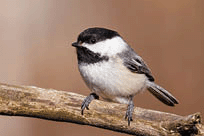Return to 4th Quarter 2022 articles.



If you have a bird feeder on your property, you are probably familiar with chickadees found throughout the United States, Canada, and Mexico. The six North American chickadee species do not have large fat reserves like some birds. Instead, their trim size gives them more mobility to evade predators such as cats or sharp-shinned hawks. However, it also means chickadees must find enough fuel daily to maintain their metabolism.
One way chickadees survive is by lowering their body temperature at night. A chickadee's daytime body temperature is 108 degrees Fahrenheit, but it drops to around 86 degrees at night. This controlled hypothermia is a nocturnal semi-hibernation that slows their metabolism by about 25%. The next day, they must find enough food to maintain their daytime metabolism while replacing fat lost the previous night.
Besides the seeds at our bird feeders, chickadees eat caterpillars, insects, spiders, and conifer seeds. Since chickadees do not migrate south for the winter, they store food for use during the cold months. Their stockpiles exist in various places, such as wedged into pine needle clusters or tree bark or even pounded into the ground. In addition, they store food in the lower branches of conifer trees, so it will be available when the upper branches are covered with snow.
Storing food for later use requires remembering where it is, and studies have shown that chickadees can remember where they stored items for months. The hippocampus is the area of the brain involved in memory and spatial learning. When food storage moves into high gear in the fall, the chickadee brain grows new neurons in the hippocampus. Their brain stores visual cues such as the spatial relationship between significant landmarks, allowing them to remember their cache locations from fall until the following spring. The complexity of chickadees is extraordinary. They are another example of God's design in the natural world, enabling the survival of a small creature we take for granted.
Picture credits:
© Aaron J Hill. Image from big stock.com
